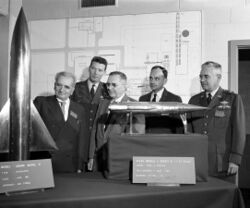AGARD
Topic: Engineering
 From HandWiki - Reading time: 2 min
From HandWiki - Reading time: 2 min
The Advisory Group for Aerospace Research and Development (AGARD)[1] was an agency of NATO that existed from 1952 to 1996.
AGARD was founded as an Agency of the NATO Military Committee. It was set up in May 1952 with headquarters in Neuilly sur Seine, France .
In a mission statement in the 1982 History it published, the purpose involved "bringing together the leading personalities of the NATO nations in the fields of science and technology relating to aerospace".[2]:iv The Advisory Group was organized by panels:
- Aerospace medical, avionics, electromagnetic wave propagation, flight mechanics, fluid dynamics, guidance and control, propulsion and energetics, structures and materials, and technical information.[2]:95–194
In 1958 Theodore von Kármán hired Moe Berg to accompany him to the AGARD conference in Paris. "AGARD's aim was to encourage European countries to develop weapons technology on their own instead of relying on the U.S. defense industry to do it for them."[3]
Activities
There were annual meetings, frequently in Paris, but also in Delft, Turin, Cambridge, Washington DC.[2]:45–70 The Advisory Group administered a consultant and exchange program including lecture series and technical panels.
The AGARD publishing program included a multilingual aeronautical dictionary, about ninety titles per year, with a normal run of 1200. An Agardograph is a work prepared by, or on behalf of, AGARD's panels.[2]:217 For example, an agardograph on the AGARD-B wind tunnel model was prepared.[4]
Later examples of AGARD studies include such topics as non-lethal weapons, theatre ballistic missile defence, protection of large aircraft in peace support operations, and limiting collateral damage caused by air-delivered weapons. AGARD was also one of the first NATO organizations to cooperate with Russia in a mutual exchange of information dealing with flight safety.
AGARD merged with the NATO Defence Research Group (DRG) in 1996 to become the NATO Research and Technology Organisation (RTO).[5]
See also
Notes
- ↑ Jan van der Bliek Editor AGARD The History 1952-1997: RTO,1999, ISBN:92-836-1079-2.
- ↑ 2.0 2.1 2.2 2.3 Frank Wattendorf & Rolland A. Willaume editors (1982) The AGARD History 1952 — 1981, AGARD Publishing
- ↑ Dawidoff, Nicholas (1994). The Catcher Was a Spy: The Mysterious Life of Moe Berg. New York: Vintage Books. p. 258. ISBN 0-679-76289-2.
- ↑ R. Hills (1961) A Review of Measurements on AGARD Calibration Models , AGARDograph 64, Aircraft Research Association Bedford, England, 1961
- ↑ Keith L. Gardner and Terry A. Franks (January 1997) NATO's new Research and Technology Organization , NATO Review 45(1): 20,1
Further reading
- Theodore von Kármán with Lee Edson (1967) The Wind and Beyond: Theodore von Kármán Pioneer in Aviation and Pathfinder in Space: Little, Brown and Company
- The AGARD History 1952-1987 (1999), Advisory Group for Aerospace Research & Development, ISBN:92-835-1562-5
External links
 |
24 views | Status: cached on August 04 2024 05:14:08
↧ Download this article as ZWI file
 KSF
KSF
